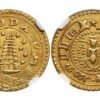History of Conquerors of India and Their Currencies
The history of India is written not only in battles and dynasties but also in its coins. Every conqueror and ruler left behind a distinct coinage system that reflected their power, culture, and economic conditions. From the earliest punch-marked pieces to the modern rupee, coins have served as miniature records of India’s past.
Ancient India – Janapadas & Mauryas (6th Century BCE – 2nd Century BCE)
The earliest coins of India were the punch-marked coins issued during the Janapadas and later standardized under the Mauryan Empire. These were mostly made of silver, cut into small rectangular or irregular shapes, and stamped with multiple symbols such as the sun, animals, or trees. Chandragupta Maurya and Ashoka ensured uniform weight standards with the karshapana, weighing around 3.4 grams. These coins mark the beginning of India’s monetary economy and laid the foundation for future coinage traditions.
Indo-Greeks (2nd Century BCE – 1st Century CE)
When the Indo-Greek rulers extended their control into northwest India, they introduced portrait coins for the first time. Their silver and copper coins bore lifelike images of kings such as Demetrius and Menander on one side, while the reverse featured Greek gods or Indian deities. The legends were bilingual, written in Greek on one side and in Prakrit or Kharosthi on the other. This blending of cultures not only facilitated trade but also marked a new artistic phase in Indian numismatics.
Kushan Empire (1st – 4th Century CE)
The Kushans, under rulers like Kanishka, issued some of the most remarkable gold and copper coins of ancient India. These coins carried portraits of the rulers alongside depictions of deities drawn from Greek, Persian, Indian, and Buddhist traditions, reflecting the empire’s multicultural identity. The Kushan coinage is especially important as it includes the earliest known images of the Buddha on coins. Their gold dinars are considered among the finest examples of Indian numismatic wealth, supported by the flourishing Silk Road trade.
Gupta Empire (4th – 6th Century CE)
The Gupta period is often called the golden age of Indian coinage. The empire issued stunning gold coins, or dinars, that depicted kings performing rituals, hunting lions and tigers, or even playing musical instruments. The reverse sides usually carried images of Hindu gods and goddesses such as Lakshmi, Vishnu, and Kartikeya. Silver and copper coins were also struck, though less artistically refined. These coins not only testify to the wealth of the empire but also to the flowering of art and religion during the Gupta age.
Delhi Sultanate (1206 – 1526 CE)
With the arrival of the Delhi Sultans, Indian coinage entered a new phase. The most common issues were silver tankas and copper jitals, which bore inscriptions in Arabic or Persian rather than images. Islamic traditions discouraged depictions of living beings, so coins of this era focused on elegant calligraphy of rulers’ names and religious verses. Alauddin Khilji introduced reforms, issuing heavier silver tankas to stabilize the economy. The Sultanate coinage represents a shift from symbolic imagery to textual authority in India’s monetary system.
Mughal Empire (1526 – 1857 CE)
The Mughal Empire perfected the Indian rupee. Introduced by Sher Shah Suri and continued by the Mughals, the silver rupee weighed about 11.66 grams and became the standard across the subcontinent. The Mughals also issued gold mohurs and copper dams, each bearing beautifully inscribed Persian calligraphy that often included the name of the ruler, the mint, and the regnal year. Akbar experimented with Din-i-Ilahi coins, while Jahangir famously issued zodiac series coins that are now among the rarest and most valued. The Mughal rupee would later serve as the model for Indian currency for centuries.
Regional Kingdoms (16th – 18th Century CE)
After the decline of the Mughal Empire, several regional powers struck their own coins. The Marathas issued silver rupees imitating Mughal styles but infused with local symbols. The Vijayanagar kings produced gold pagodas, often depicting deities. Tipu Sultan of Mysore introduced a highly original coinage with tiger motifs, Persian inscriptions, and a new calendar system. The Sikh Empire struck coins in the name of Guru Nanak and carried religious phrases that reflected Sikh faith. These regional issues highlight the assertion of cultural independence and local pride.
British East India Company (1600 – 1858 CE)
When the British East India Company gained control, they initially issued coins in the name of the Mughal emperors to secure local acceptance. Gradually, each presidency—Bombay, Madras, and Calcutta—developed its own coinage. Later, machine-struck coins featuring the Company arms and English legends became standard. This transition from handmade to machine-struck coins marked a technological shift and set the stage for uniform colonial currency.
British Raj (1858 – 1947 CE)
After 1858, India came under direct rule of the British Crown. Coins now bore the portraits of British monarchs such as Queen Victoria, Edward VII, George V, and George VI. Denominations included the rupee, half-rupee, quarter-rupee, annas, and pies. At first, coins were rich in silver, but rising bullion costs led to the introduction of copper-nickel alloys. The designs were highly standardized: the monarch’s effigy on one side and the denomination with date on the reverse. These coins reflected the colonial administration’s control and introduced the system that continued into independent India.
Republic of India (Post 1947)
Independent India issued its first coins in 1950, carrying the Lion Capital of Ashoka as the national emblem. For the first few years, the system of annas and pies continued, but in 1957 India adopted the decimal system, dividing the rupee into 100 paise. Metals changed over the decades from nickel and copper to aluminum and stainless steel. Modern issues include commemorative coins celebrating leaders, events, and cultural achievements. Today’s coins symbolize India’s sovereignty and evolving identity while still carrying the legacy of centuries of numismatic tradition.
Conclusion
The story of India’s conquerors is mirrored in its coinage. From the earliest punch-marked pieces of the Mauryas to the refined gold coins of the Guptas, the calligraphic issues of the Delhi Sultans, and the standardized rupees of the Mughals, each era left behind a unique legacy. Regional powers asserted their identity through distinctive motifs, while the British introduced machine-struck uniformity that evolved into the modern Indian rupee. Together, these coins form a living timeline of India’s political, cultural, and economic journey. For collectors and historians alike, they are not merely instruments of trade but enduring symbols of the nation’s diverse and layered past.





